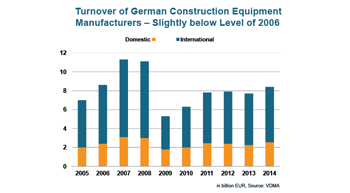
German CE sector grows
Turnover achieved by German manufacturers of construction equipment in 2014 grew by eight per cent, equaling ?8.4 billion in total, and, with this, is higher than was originally expected. This amount is about the same as was reached in 2006. ?Turnover is one thing, profit is another,? Joachim Strobel, Deputy Chairman of the Construction Equipment and Building Material Machinery Association of the German Engineering Federation (VDMA) and Managing Director of Liebherr EMtec GmbH put the figures in perspective. The short time space in which new European exhaust emissions regulations come into effect meant extremely high investments in development, which were not self-financing, he explained. First of all, newly developed machinery needs to be put to market and sold to customers. For the current year, the German construction machinery industry is only expecting a sideways trend in total, as the businesses in very good and less prosperous markets tend to equal out.
Strobel did not forecast any threatening to the relevant manufacturers? existences, although he did admit that long-term planning is becoming increasingly more difficult. ?Few years back, we were used to seeing seven-year-cycles? this is a thing of the past.?In 2014, there was a strong spring, a long summer slump and finally again a significant improvement of the situation towards the end of the year. At the bottom line, incoming orders were seven per cent higher than in the previous year. This is mainly due to the good demand in earthmoving and road construction equipment. Large equipment, however, have been sold much less, mainly due to the difficult situation of the global mining industry, he said. The building construction machinery area is recovering rather slowly and is still 50 per cent lower in turnover today than in boom years.
German market stable
In 2014, the German market exceeded all expectations with its growth of nine per cent and showed stability once again. ?Companies are expecting the market to also develop in a positive way in 2015, even though there is not too much room for improvement on the domestic market,? Strobel said. Portugal and Spain are slowly emerging again, however, starting at a very low level. Although there is a high heterogeneity to be stated, sales in construction equipment in 2014 increased by 15 per cent in all of Europe compared to the previous year. The highest demand was in road building machinery. Slowly, the European construction economy seems to return to growth, even though there are dark clouds on the French sky. There are no investments being made anymore in this second most important European market for compact engines. Also, there are hardly any calls to bid anymore due to political irritations.
In addition, the construction equipment rental companies, a big customer segment, do not show a high willingness to invest either. Apparently, they are still trying to position themselves with regard to exhaust emission levels IIIA, IIIB and those to come, Strobel thought. The fact that business is missing in Russia is also worrying. Sales declined by 37 per cent compared to the previous year and, in light of the current political tensions, recovery is not yet to be expected.
Traditional markets a glimmer of hope
Business with the US is on an upturn, especially with current conversion rates being helpful. In 2014, companies have been able to increase their sales in this region by 19 per cent. There are positive signs also for 2015. The same is true for the MENA-countries, particularly Saudi Arabia. In contrast to this, BRIC did not fulfill their promise. In China, the industry had to cope with the third double-digit decline in a row. There is no sign of a reversal in trend for 2015, with machinery being very modern and surplus capacities enormous there. In India, admittedly, the construction industry?s mood has improved, but with no direct effect on sales yet. South America as well as the African continent is still behind expectations; only Egypt provides boost with the expansion of the Suez Canal.
Investment in environment technology
In 2015, many manufacturers of construction equipment will again have to invest immensely in order to implement the European exhaust emission levels as required by 97/88/EC. Currently, the regulations are being reviewed; voting in the European Council and Parliament has yet to take place. According to Strobel, the so-called level V therein prescribes new limits which are doable; the main focus of the discussion is on the deadlines to implement these new regulations. He said that a deadline of January 1, 2020, for mobile machinery comprising the categories from 56 to 130 kW, as well as January 1, 2019, for all other machines in all categories, is rather ambitious. ?With development periods being five years and in light of the technical developments required, these deadlines are far too tight,? Strobel believes.
The industry is therefore fighting in Brussels to achieve a prolongation for the deadlines to implement and more predictability and possibility, to plan. Since the regulations were first introduced in 1999, mobile machinery?s emissions have already been decreased by more than 95 per cent for NOx and PM. This was possible, thanks to enormous technological improvements as well as investments. Now, another large amount will be required to keep up with the necessary developments, without significant refinancing in sight.
- Joachim Strobel, Deputy Chairman, Construction Equipment and Building Material Machinery Association, VDMA
?We cannot expect more than a sideways trend for the German manufacturers of construction equipment in 2015?
In 2014, there was a strong spring, a long summer slump and finally again a significant improvement of the situation towards the end of the year. At the bottom line, incoming orders were seven per cent higher than in the previous year.


 +91-22-24193000
+91-22-24193000 Subscriber@ASAPPinfoGlobal.com
Subscriber@ASAPPinfoGlobal.com